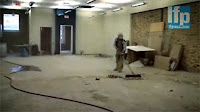The facades of two, fine downtown buildings — the former Capitol Theatre and the former Bowles Lunch building — have been spared. Well, at least that of the Capitol. Well, at least part of it.
Whatever, The London Free Press sees this as a win-win event for the city and the developer involved. According to the paper ". . . these buildings were originally written off, considered too expensive to restore."
As I recall, the naysayers said the cost to restore the Capitol Theatre auditorium would have been prohibitive. Well, the auditorium was not saved. Perhaps the naysayers were more right than wrong and perhaps that is the reason these two buildings seen more demolition than restoration.
The Free Press congratulates the developer and the City of London for saving "a key part of our history" and doing it in a truly imaginative manner. And what was this imaginative manner? It was the demolition of the key part of the heritage theatre — the auditorium, the theatre itself. Paul Berton, editor-in-chief of the Free Press, admits ". . . the back end of the Capitol theatre is gone" and then quickly adds "at least the facade is safe."
Today the paper often refers to the Capitol Theatre as just the Capitol. The theatre part, the part with the 1400 seats at its opening in 1920, is now a parking lot.
The loss of the Capitol Theatre is a huge blow to London, and not just the downtown. Originally called the Allen Theatre, it was designed by the renown theatre architect C. Howard Crane. Crane was responsible for the design of some 250 theatres across North America. When you think of the Fox Theatre in Detroit, think of Crane. And the United Artist Theatres in Detroit or Los Angeles, take your pick, think of Crane again. (Architect Charles Howard Crane shown)
The Fox has been described as Hindu-Siamese-Byzantine or Far Eastern-Indian-Egyptian in design. The lavish theatre cost about $12 million to build in 1928. It underwent an $8.1 million restoration in 1988. Detroit can be proud. London? I'm not so sure.
In 1988 $8.1 million U.S. was about $10 million Canadian. Using the Bank of Canada Inflation Calculator, I learned that $10 million in 1988 would be $15.9 million in today's dollars. So, Detroit restored the entire Fox Theatre for just four times what it cost London to sort of save just two facades. (The restored Fox Theatre in Detroit is shown.)
According to The London Free Press, "the Bowles Lunch used to have a terracotta front, but 80% of the 400 tiles were damaged. The decision was made to demolish the original facade and rebuild it in carved stone.
Some descriptions of the Capitol Theatre mention its terracotta front and how the Bowles Lunch was made to match its neighbour. It is more accurate to say the Bowles Lunch facade was replaced — not restored.
The screen-grab is from The London Free Press story claiming "two side-by-side downtown London historic gems that came close to a date with the wrecker's ball have returned to their former glory." Oh? Look at the screen-grab. This is not the Fox Theatre restoration.
Berton tells us we are beginning to realize the potential in heritage buildings . . . "because they are unique and interesting . . ." Berton seems to have forgotten we are talking about facades here. There is nothing unique or interesting about the commercial space being swept by the construction worker.
Berton tells us that Londoners owe a debt of gratitude to the developer for showing his faith in these two structures. Faith in these two structures or a concern for the facades? The developer himself wrote in a letter to the city that some of the interior detailing in the old theatre was donated to the Park Theatre and some to the Aeolian Hall for use in renovation projects. (For that generosity we owe the developer a thank you.) Unfortunately this was done in preparation of the theatre's demolition, clearing the way for a long-planned parking lot.
According to the city, the developer's company acquired the Bowles Lunch building in August 2006 for $250,000 and the Capitol Theatre in June of 2006 for $890,000. From the city records posted online one learns an inquiry was made by the developer "with respect to possible demolition of the Capitol Theatre building" in late 2005. This was before the theatre had even been purchased. The developer ripped down the theatre three months after he gained control of the property.
Berton tells us, "If London is to thrive, these are the kinds of projects that will lead us into the future." I don't think so. Berton may not think much of "gargantuan movie theatres" but the old ones once found in downtown London did have some cool features — like screens and seats.
_______________________________________________________
You will notice that the developer's name has not been used in this post. The developer is not a bad person; the developer is a developer. He runs a profitable business and not a charity. And make no mistake, the facades were worth saving with the finished appearance actually quite good.
Subscribe to:
Post Comments (Atom)
Sech SCB568P Smartwatch is available from Canadian Tire
All I wanted was watch with an alarm. That's all. I take oodles of pills for my heart and at four different times during the day. I of...

-
The following is an old post. It has been updated but it is still old. A new post on this topic can be found here -- Pickles: Not made in O...
-
Update -- 2019 -- Disney "pink slime" lawsuit settled for whopping $177 million. From the linked article: " Five years...
-
Note steam sealing lip on decades-old Lifetime cookware. My wife just inherited some stainless steel cookware: Lifetime brand. I to...







No comments:
Post a Comment